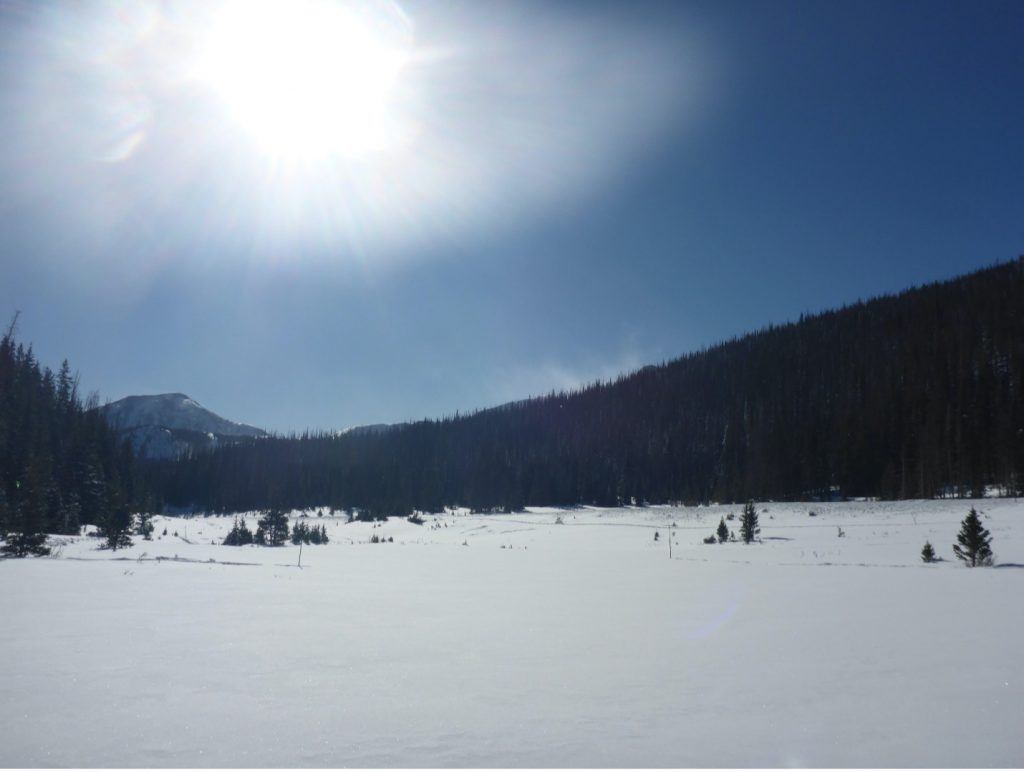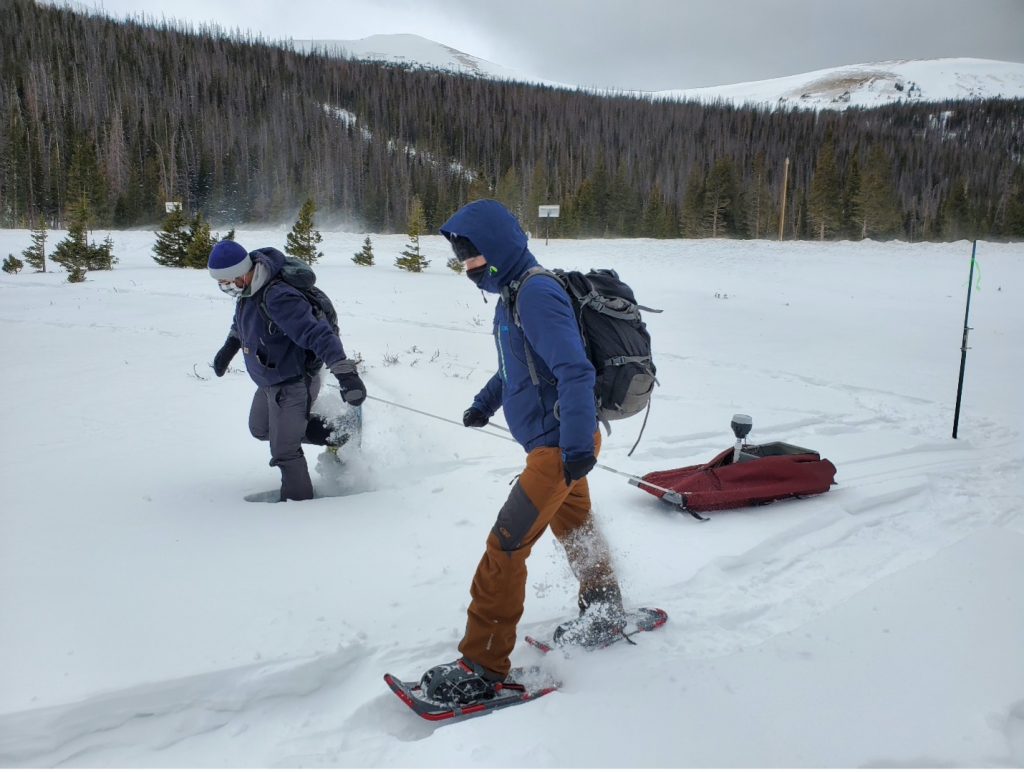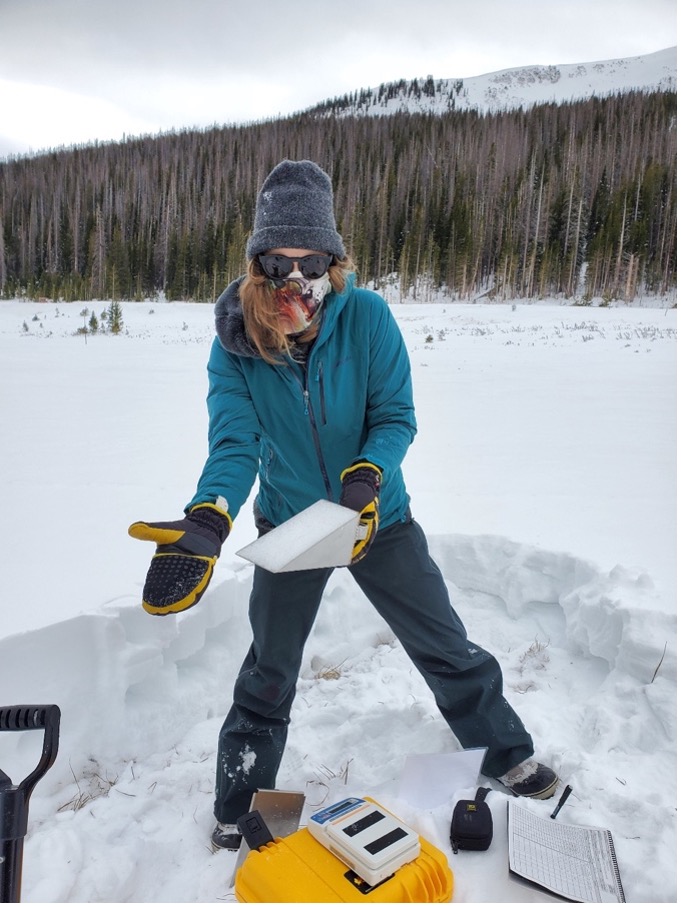By Dan McGrath and Randall Bonnell, Colorado State University /CAMERON PASS, COLORADO/
The word lightspeed conjures different images for different people. Star Wars fans may connect lightspeed to the Millennium Falcon, while radar scientists may think of the velocity of electromagnetic energy. Radio waves, a form of electromagnetic energy, travel at “lightspeed” through a vacuum, but when they encounter snow, they slow down drastically. Sounds bad, right? It might be if you’re trying to get somewhere fast, but if you’re trying to measure the amount of snow on the ground, it’s just what you’re looking for.

Over the past four months, our team from Colorado State University, along with teams across the western United States, has been tramping around in the snow each week trying to figure out just how much those radio waves might be slowing down. Why? In 2021, the NASA SnowEx campaign is focused on testing the use of airborne L-band Interferometric Synthetic Aperture Radar (InSAR). In this method, an instrument aboard a plane sends out radio waves to measure changes in snow-water equivalent (SWE) – or the amount of water stored in the snowpack – down below. The basic premise of this approach is that as more and more snow accumulates on the ground, it takes a radar wave longer and longer to travel from the aircraft, through the snow to the ground, and back to the aircraft. Each week, the NASA Uninhabited Aerial Vehicle Synthetic Aperture Radar (UAVSAR) team flies a plane overhead to collect InSAR observations of the snowpack. Meanwhile, we collect ground observations to document changes in snow depth, SWE, and other characteristics of the snow to help evaluate InSAR as a way of measuring SWE.
There are a lot of different ways to measure snow on the ground. You can probe it to measure its thickness or temperature, you can dig through it to measure its mass and density, and you can employ all kinds of fancy equipment to measure things like the surface area of grains of snow, or spectral reflectance. But trying to determine any of these details on a global scale from instruments in space becomes much more difficult. Even a fundamental question, like how much SWE is in a basin, can be difficult to answer.
Radio waves might be one answer to this difficult question. As radio waves travel through the snowpack, their velocity depends on the density of the snow. For example, denser snow means the radio waves will move more slowly. If we can measure the travel time (or phase, more on that later) of those radio waves very precisely, we can calculate SWE accurately. For these reasons, the SnowEx21 campaign is an exciting campaign – but what makes it even more important is its applicability. In 2022, NASA and Indian Space Research Organization (ISRO) will launch NISAR, a space based InSAR mission. It will carry a L-band (1-2 GHz frequency) radar instrument, meaning that those slow radar waves we’re evaluating from UAVSAR will soon be making the trip from space!

During the SnowEx21 Campaign, our team has been making weekly trips to Cameron Pass, a site at about 10,000-foot elevation about two hours west of Fort Collins, Colorado. One of the key observations we made each week was repeat ground-penetrating radar (GPR) surveys along multi-kilometer transects. GPR works by transmitting a radar pulse into the snow and measuring the two-way travel time and strength of the returning signal to produce a radargram. These surveys are particularly valuable for evaluating UAVSAR, as there is significant overlap between the methods.
We dig snow pits and measure the density of the snowpack to determine a velocity for converting the GPR-measured travel time to depth and SWE. By taking repeat measurements in the same areas week after week, we can measure a change in travel time, snow depth, and SWE between each interval, thereby providing a direct comparison to what UAVSAR is measuring. UAVSAR and other InSAR-based approaches measure changes in phase (a portion of an electromagnetic wave) between two subsequent radar acquisitions. This change in phase, on par with the change in travel time for our GPR instrument, is the key to detecting changes in SWE. However, phase changes are inherently complex and there is still much to discover regarding their interpretation. That is where other ground observations come into play.

Each week, we dug snow pits at two different sites to measure density, stratigraphy, and temperature of the snowpack. Density measurements are used to estimate a radar velocity for calculating snow depth and SWE from GPR travel times. Stratigraphy observations identify layers in the snowpack, which may influence InSAR or GPR observations. Temperature (and its corresponding gradient within the snowpack) is used to understand how snow crystals are changing and for identifying the presence of liquid water, as water strongly influences radar velocity. Additionally, understanding soil conditions – like whether the ground is frozen or thawed – and ground cover such as vegetation is key to interpreting InSAR observations. Outside of the pit, we also measured snow depths using a GPS-equipped probe, providing an additional approach to measure the change in SWE between each UAVSAR flight.

While intergalactic space travel is still science fiction, the use of radar to measure our global snow resources from space is becoming a reality. The SnowEx21 campaign is providing a critical link between theory and practice and, after a good deal of data analysis, it will undoubtedly leave a refined view of the capabilities and limitations of L-band InSAR for measuring changes in SWE. Such progress is necessary, as snow is a critical and highly valued resource relied on by billions of individuals around the world. Climate change is directly impacting this resource in a multitude of ways, including a reduction in the length of the snow-covered season and the total amount of snow that accumulates, and the impacts are predicted to become much more severe by mid-century. As such, the need for accurate, global estimates of SWE has never been more urgent. While SnowEx21 is only one small part of the puzzle, we’re hopeful that the progress made during this campaign will contribute to realizing this goal.
